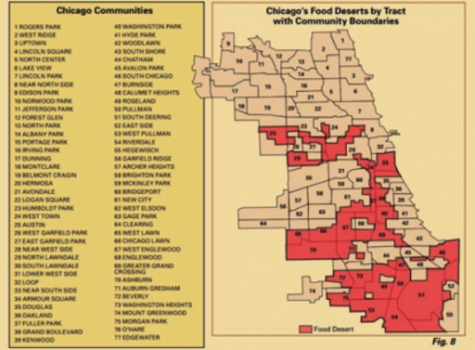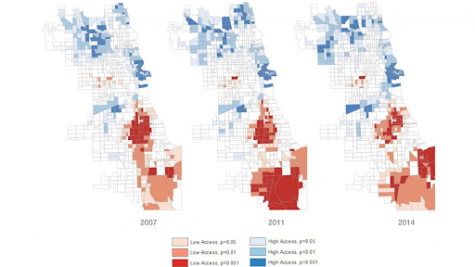Food Deserts in Chicago
April 22, 2021
![]()
As defined by the US Department of Agriculture, a food desert is “an area with a poverty rate of at least 20 percent and where at least a third of the population lives more than a mile from a supermarket or large grocery store.” The limited access to affordable and nutritious food due to cost and lack of grocery stores in the area forces people living in these food deserts, commonly black and brown people, to frequently get meals from fast food restaurants because they are a lot more accessible. As a result, residents of food deserts have a higher risk of diabetes, obesity, cardiovascular disease, and other conditions related to diet. This explains why obesity is more prevalent among ehtnic minority and low-income populations. According to the Food Empowerment Project, in Chicago, there are estimated to be more than 500,000 people living in food deserts and the majority of the food deserts are located on the South and West sides of the city. Another 400,000 live in areas filled with fast food restaurants but lack nearby grocery stores. It is important to tackle this issue of food insecurity and food deserts in your city because of the severe health effects it has on these populations and communities long-term.


As a result of food deserts, many people do not have access to healthy foods, leading to malnutrition and vitamin deficiencies, which have serious consequences. Malnutrition is the cause of almost half of all deaths of children under five and the primary cause of many chronic diseases in adults. For example, Vitamin A deficiencies lead to increased mortality in infants and children, Iodine deficiencies can cause physical and physiological development, Iron deficiencies (anemia) can lead to general ill health, and zinc deficiencies inhibit physical growth in children and can make one more susceptible to certain diseases. Lack of access to proper nutrition affects productivity and general well being, making it a large contributing factor to many other societal problems. In order to increase the accessibility of essential vitamins, the government and citizens can take action.
Solutions to reduce food deserts include:
- Providing education about food preparation, production, and nutrition to low-income and ethnic minority populations. This would increase awareness of the danger of constant consumption of fast food and encourage healthy eating habits.
- Support community gardens. This would allow people to grow their own fresh and healthy food.
Improve public transportation options, making it easier for people to travel the distances to grocery stores. - Communicating with local representatives to ensure the residents of these communities can voice their opinions about food-related decisions.
- Tax breaks for stores carrying fresh produce, which would encourage stores to carry fresh, healthier, food through monetary incentives.
- Loans to Mom and Pop stores, allowing stores to have the extra money in the beginning to start stocking fresh and healthier food.
Want to help the cause? Here are some petitions you can sign to reduce food deserts and end hunger in Chicago:
- https://www.change.org/p/j-b-pritzker-eliminating-food-deserts-3acef177-14b7-4acd-8805-7eb4c79b567b
- https://sign.moveon.org/petitions/eliminate-food-deserts
- https://www.chicagosfoodbank.org/take-action/
Visit this link to learn about more ways to get involved in solving this issue: https://www.chicagosfoodbank.org/get-involved/.